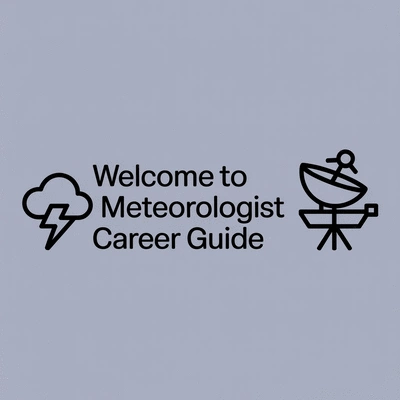What if your understanding of weather could not only inform your daily plans but also save lives? The role of a meteorologist extends far beyond simple forecasts, intertwining science with real-world applications to create a significant impact on communities across Australia.
What You Will Learn
- Meteorologists analyze atmospheric data to forecast weather, crucial for sectors like agriculture and emergency services.
- Key responsibilities include collecting data, analyzing weather patterns, and communicating findings effectively to the public.
- Essential instruments used in Australia include weather balloons, radar systems, and satellite imagery for accurate data collection.
- A successful meteorologist balances technical skills with effective communication to provide insights that communities can trust.
- Pursuing a career in meteorology requires exploring educational pathways and seeking mentorship opportunities from current professionals.
The Meteorologist's Toolkit and Responsibilities
Meteorologists use a range of instruments and perform crucial tasks to ensure accurate weather forecasting and public safety. Below is a visual representation of their key responsibilities and essential tools.
Key Responsibilities
- ✓ Weather forecasting
- ✓ Data collection & analysis
- ✓ Disaster preparedness
- ✓ Public communication
Essential Instruments
- ⚡ Weather balloons
- ⚡ Radar systems
- ⚡ Satellite imagery
- ⚡ Automatic weather stations
Understanding the Role of an Australian Meteorologist
As a meteorologist, my work extends beyond simply predicting the weather. It plays a crucial role in our daily lives and impacts various sectors, from agriculture to emergency services. Understanding what a meteorologist does is essential, especially in a country like Australia, where weather can be both beautiful and extreme! The Australian Meteorological and Oceanographic Society (AMOS) provides further insights into the professional community and their contributions to science and society.
So, what exactly is a meteorologist? In essence, we are scientists who study the atmosphere and use our knowledge to forecast weather conditions. Our work is vital because it helps people prepare for the unexpected, whether it's a sunny day at the beach or a powerful storm that could disrupt lives. It’s my passion to ensure that others have access to accurate weather information, often relying on data and forecasts provided by the Bureau of Meteorology (BOM), Australia's national weather, climate, and water agency!
What is a Meteorologist and Why is Their Work Important?
Meteorologists are the experts who analyze atmospheric data to understand and predict weather patterns. This expertise is important because it not only helps individuals make decisions about their day but also supports industries that rely on weather forecasts. For example, farmers depend on accurate forecasts to plan their planting and harvesting schedules.
- Weather forecasting for daily activities
- Guiding disaster preparedness and response
- Informing agricultural decisions
- Supporting aviation and marine operations
By providing reliable forecasts, meteorologists contribute to the safety and efficiency of various sectors, making our work indispensable in a country marked by diverse climates.
Key Responsibilities: Weather Forecasting and Data Collection
One of the primary responsibilities of a meteorologist is to collect and analyze weather data. This includes using various meteorological instruments to measure temperature, humidity, wind speed, and atmospheric pressure. Each piece of data helps create a clearer picture of current and future weather conditions. The Centre for Australian Weather and Climate Research (CAWCR) plays a crucial role in advancing the science behind these analyses.
- Collecting data from ground stations and satellites
- Analyzing historical weather patterns
- Using computer models for forecasting
- Communicating findings to the public and stakeholders
By performing these tasks, meteorologists ensure accurate weather forecasting, which is critical for public safety and informed decision-making.
Essential Meteorological Instruments Used in Australia
To effectively carry out our forecasting duties, meteorologists utilize a range of instruments. These tools are essential for gathering precise weather data and making informed predictions. In Australia, some of the most important instruments include:
- Weather balloons for upper-atmosphere data
- Radar systems for tracking precipitation
- Satellite imagery for observing large weather systems
- Automatic weather stations for real-time data collection
Each instrument provides unique insights into weather conditions, allowing us to create comprehensive forecasts that serve the diverse needs of the Australian public.
Pro Tip
Did you know? Engaging with local weather phenomena can enhance your understanding of meteorology. Consider joining community weather observation groups or participating in citizen science projects. These experiences not only deepen your knowledge but also connect you with others who share your passion for weather!
Frequently Asked Questions About Meteorologists
What is the primary role of a meteorologist?
A meteorologist's primary role is to study the atmosphere, analyze weather data, and forecast weather conditions to help individuals and various sectors prepare for atmospheric events.
Why is a meteorologist's work particularly important in Australia?
In Australia, a meteorologist's work is crucial due to the country's diverse and often extreme weather patterns, impacting sectors from agriculture to emergency services and public safety.
What instruments do meteorologists use for forecasting?
Meteorologists use various instruments such as weather balloons for upper-atmosphere data, radar systems for tracking precipitation, satellite imagery for large weather systems, and automatic weather stations for real-time data.
What skills are essential for a successful career in meteorology?
A successful meteorologist needs a balance of strong technical skills for data analysis and effective communication skills to convey complex information clearly to the public and stakeholders.
How can one pursue a career in meteorology?
To pursue a career in meteorology, individuals should research educational pathways in atmospheric sciences, seek mentorship from current professionals, and participate in workshops to gain hands-on experience.
Summary: The Dynamic Life of an Australian Meteorologist
As we reflect on the journey of becoming a meteorologist, it's clear that this career is a unique blend of science and real-world application. Each day presents a new opportunity to tackle the complexities of weather patterns and their impacts on our environment. Whether it's predicting rain to help farmers or providing crucial information to emergency services, the role of a meteorologist is both impactful and rewarding. I often find myself astonished by how much our understanding of weather can improve daily decisions for individuals and communities alike.
For anyone considering this path, it's essential to appreciate the balance between technical skills and effective communication. Meteorologists must interpret complex data and convey it in a way that is accessible to the public. This duality makes the profession not only scientifically rigorous but also profoundly human-centered.
Balancing Science and Real-World Application in Meteorology
In my experience, a successful meteorologist is someone who thrives in both the scientific and practical aspects of the job. This balance allows us to deliver forecasts that are not just numbers, but valuable insights that people can trust. Here are a few key areas where science meets application:
- Data Analysis: Utilizing various tools to predict weather changes accurately.
- Public Communication: Explaining forecasts to the community in clear, understandable language.
- Collaboration: Working with different sectors, from agriculture to emergency management, to ensure everyone has the information they need.
The fusion of these elements not only enhances our forecasts but also strengthens relationships with the communities we serve. As meteorologists, we have the privilege of being part of critical conversations that can save lives and support livelihoods!
Encouragement to Pursue a Career in Meteorology
If you're excited about weather and science, I wholeheartedly encourage you to explore a career in meteorology! This field is filled with opportunities for those who are curious, proactive, and passionate about understanding our planet. You don’t have to be an expert in every area to start; what matters is your eagerness to learn and discover. Remember, every accomplished meteorologist began as a novice!
Think about the following steps to kickstart your journey:
- Research Education Options: Look into universities offering degrees in meteorology or atmospheric sciences.
- Engage with Professionals: Seek mentorship or advice from current meteorologists.
- Participate in Workshops: Find opportunities to gain hands-on experience and broaden your skills.
As you embark on this journey, know that your passion for weather science can make a significant difference, not just in your life but in the lives of others. At the Meteorologist Career Guide, we’re dedicated to supporting you every step of the way, providing the resources and insights to help you thrive!
Recap of Key Points
Here is a quick recap of the important points discussed in the article:
- Meteorologists play a crucial role in predicting weather and its impact on various sectors, including agriculture and emergency services.
- Key responsibilities include data collection, analyzing patterns, and effective communication of forecasts to the public.
- Meteorologists utilize essential instruments like weather balloons, radar systems, and satellites for accurate forecasting.
- A successful meteorologist balances technical skills with the ability to communicate complex data clearly.
- Aspiring meteorologists are encouraged to research educational pathways, seek mentorship, and gain hands-on experience through workshops.










